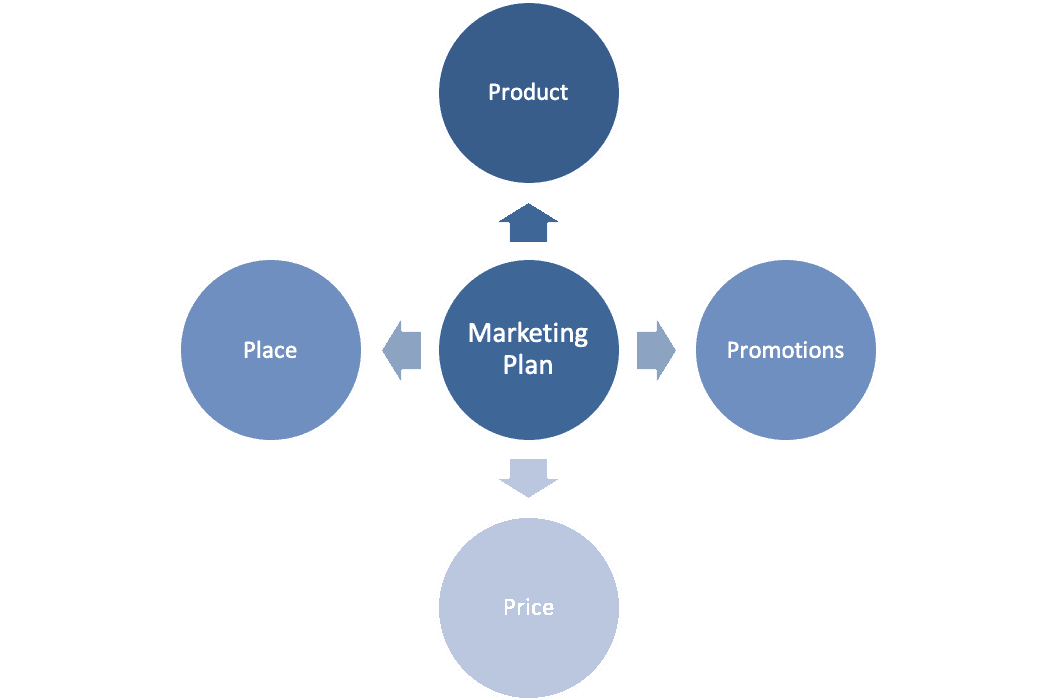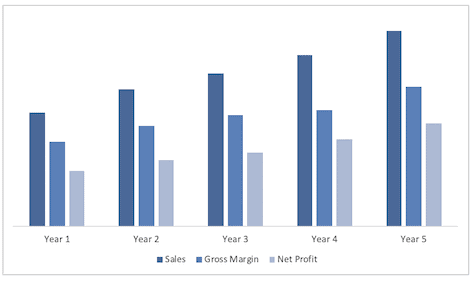Bookkeeping Business Plan
Over the past 20+ years, we have helped over 9,000 entrepreneurs create business plans to start and grow their bookkeeping companies. On this page, we will first give you some background information with regards to the importance of business planning. We will then go through a bookkeeping business plan step-by-step so you can create your plan today.
What is a Bookkeeping Business Plan?
A business plan provides a snapshot of your business as it stands today, and lays out your growth plan for the next five years. It explains your business goals and your strategy for reaching them. It also includes market research to support your plans.
Why You Need a Business Plan for a Bookkeeping Business
If you’re looking to start your own bookkeeping business or grow an established business, you need a business plan. A business plan will help you raise funding, if needed, and plan out the growth of your bookkeeping business in order to improve your chances of success. Your business plan is a living document that should be updated annually as your company grows and changes.
Sources of Funding for Bookkeeping Startups
With regards to funding, the main sources of funding for a bookkeeping business are personal savings, credit cards, bank loans, and angel investors. With regards to bank loans, banks will want to review your business plan and gain confidence that you will be able to repay your loan and interest. To acquire this confidence, the loan officer will not only want to confirm that your financials are reasonable. But they will want to see a professional plan. Such a plan will give them the confidence that you can successfully and professionally operate a business.
The second most common form of funding for a bookkeeping company is angel investors. Angel investors are wealthy individuals who will write you a check. They will either take equity in return for their funding or, like a bank, they will give you a loan.
Finish Your Business Plan Today!
If you’d like to quickly and easily complete your business plan, download Growthink’s Ultimate Business Plan Template and complete your plan and financial model in hours.
How to Write a Business Plan for a Bookkeeping Company
Your business plan should include 10 sections as follows:
Executive Summary
Your executive summary provides an introduction to your business plan, but it is normally the last section you write because it provides a summary of each key section of your plan.
The goal of your Executive Summary is to quickly engage the reader. Explain to them the type of business you are operating and the status; for example, are you a startup, do you have a bookkeeping business that you would like to grow, or are you operating a chain of bookkeeping companies.
Next, provide an overview of each of the subsequent sections of your plan. For example, give a brief overview of the bookkeeping business industry. Discuss the type of business you are operating. Detail your direct competitors. Give an overview of your target market. Provide a snapshot of your marketing strategy. Identify the key members of your team. And offer an overview of your financial plan.
Company Analysis
In your company analysis, you will detail the type of bookkeeping business you are operating.
For example, you might operate one of the following types:
- Traditional Bookkeeping and Accounting Business: the traditional bookkeeping and accounting business can provide the entire range of bookkeeping services, including maintaining journals and ledgers, balancing and reconciling accounts, preparing payroll, preparing and filing taxes, and providing billing and collection services.
- Tax Preparation Services: this type of bookkeeping business primarily prepares, reviews, and/or files tax returns and supplementary documents.
- Payroll Services: this type of bookkeeping business typically collects payroll information, processes paychecks, processes withholdings, and files reports.
- Billing Services: this type of bookkeeping business deals with sending bills and collecting payments.
In addition to explaining the type of business you operate, the Company Analysis section of your business plan needs to provide background on the business.
Include answers to question such as:
- When and why did you start the business?
- What milestones have you achieved to date? Milestones could include sales goals you’ve reached, new store openings, etc.
- Your legal structure. Are you incorporated as an S-Corp? An LLC? A sole proprietorship? Explain your legal structure here.
Bookkeeping Company Analysis Example
Welcome to LedgerWise Services, a new bookkeeping service proudly serving customers in Oklahoma City, OK. As a local bookkeeping service, we’ve identified a significant gap in the market – the absence of high-quality local bookkeeping services. Recognizing this, we’ve set out to fill this void by offering unparalleled bookkeeping solutions tailored to the unique needs of our clients in Oklahoma City.
At LedgerWise Services, our offerings are comprehensive and designed to meet a wide array of financial management needs. Our services include generating detailed Monthly Financial Statements, efficient Payroll Processing, managing Accounts Payable and Receivable, conducting thorough Bank Reconciliation, and handling Tax Preparation and Filing. With these services, we aim to be the one-stop solution for businesses looking for meticulous financial management.
Our operation base is in Oklahoma City, OK, which places us in the perfect position to serve the local businesses of Oklahoma City. Being a part of the community we serve ensures that we understand the unique challenges and opportunities our clients face, enabling us to provide more personalized and effective services.
The foundation of LedgerWise Services rests on solid ground, thanks to our founder’s experience in successfully running a previous bookkeeping service. This experience, combined with our commitment to offering superior services, positions us uniquely in the market. We are dedicated to helping businesses maintain accurate financial records, comply with legal requirements, and make informed financial decisions, setting us apart from our competitors.
Since our establishment on January 4, 2024, as a C Corporation, we have achieved several milestones that mark the beginning of our promising journey. We’ve crafted a distinct logo that represents our brand’s values and ethos, developed a unique company name that stands out and resonates with our target audience, and secured a prime location that serves as our operational headquarters. These accomplishments are just the start, as we continue to build our legacy in the bookkeeping industry.
Industry Analysis
In your industry analysis, you need to provide an overview of the bookkeeping business.
While this may seem unnecessary, it serves multiple purposes.
First, researching the bookkeeping industry educates you. It helps you understand the market in which you are operating.
Secondly, market research can improve your strategy particularly if your research identifies market trends. For example, it would be helpful to ensure your plan takes into account the seasonal nature of certain services such as tax preparation.
The third reason for market research is to prove to readers that you are an expert in your industry. By conducting the research and presenting it in your plan, you achieve just that.
The following questions should be answered in the industry analysis section:
- How big is the bookkeeping industry (in dollars)?
- Is the market declining or increasing?
- Who are the key competitors in the market?
- Who are the key suppliers in the market?
- What trends are affecting the industry?
- What is the industry’s growth forecast over the next 5 – 10 years?
- What is the relevant market size? That is, how big is the potential market for your bookkeeping business. You can extrapolate such a figure by assessing the size of the market in the entire country and then applying that figure to your local population.
Bookkeeping Industry Analysis Example
The bookkeeping industry in the United States is a significant sector, with a current market size of over $40 billion. This industry has been steadily growing over the past few years, with an expected annual growth rate of 3% to 5%. This growth can be attributed to the increasing complexity of tax laws and regulations, as well as the growing number of small businesses in need of bookkeeping services.
One trend in the bookkeeping industry is the increasing use of technology to streamline processes and improve efficiency. Many bookkeeping firms are investing in software and automation tools to handle tasks such as data entry, reconciliation, and reporting. This trend bodes well for LedgerWise Services, as a new bookkeeping service in Oklahoma City, as they can leverage these technologies to provide more accurate and timely financial information to their clients.
Another trend in the bookkeeping industry is the growing demand for specialized services, such as forensic accounting, virtual CFO services, and cloud accounting. This trend presents an opportunity for LedgerWise Services to differentiate themselves in the market by offering tailored solutions to meet the unique needs of their clients. By staying ahead of industry trends and providing high-quality service, LedgerWise Services is well-positioned to succeed in the competitive bookkeeping market.
Customer Analysis
The customer analysis section must detail the customers you serve and/or expect to serve.
The following are examples of customer segments: families, entrepreneurs, businesses, retirees, etc.
As you can imagine, the customer segment(s) you choose will have a great impact on the type of bookkeeping business you operate. Clearly, families would want different pricing and product options and would respond to different marketing promotions than established businesses.
Try to break out your target market in terms of their demographic and psychographic profiles. With regards to demographics, including a discussion of the ages, genders, locations, and income levels of the customers you seek to serve. Because most bookkeeping companies primarily serve customers living in the same city or town, such demographic information is easy to find on government websites.
Psychographic profiles explain the wants and needs of your target customers. The more you can understand and define these needs, the better you will do in attracting and retaining your business clients.
Bookkeeping Customer Analysis Example
Target Customers
Our primary focus will target local residents in Oklahoma City who require personalized bookkeeping solutions. These individuals might include freelancers, independent contractors, and small business owners who need efficient management of their financial records. By providing customized services, we will address the unique financial tracking challenges faced by this segment.
In addition, we will also target small to medium-sized enterprises (SMEs) that are looking for reliable bookkeeping services to enhance their financial operations. These businesses often lack the resources to maintain an in-house accounting team and will benefit from our expertise in maintaining accurate and up-to-date financial records. Our services will help them make informed financial decisions and maintain compliance with local regulations.
We will also tailor our services to meet the needs of startups and new business ventures within the region. As these entities work on establishing their market presence, they will require robust financial management to support growth and sustainability. By offering scalable solutions, we will enable them to focus on expanding their business while we manage their bookkeeping needs.
Moreover, we will engage with non-profit organizations that need meticulous bookkeeping services to manage their funds effectively. These organizations often operate on tight budgets and require transparent financial reporting to their stakeholders. Our expertise will ensure their financial records are precise and compliant, aiding in maintaining trust and credibility with donors and partners.
Customer Needs
Customers seeking bookkeeping services have a fundamental need for the accurate and timely management of their financial records. LedgerWise Services addresses this by offering high-quality service that ensures all financial transactions are correctly recorded, providing clarity and precision in financial reporting. This accuracy not only helps businesses maintain compliance with legal and regulatory requirements but also supports strategic decision-making based on reliable financial data.
Another significant customer need is the assurance of data security and confidentiality. With LedgerWise Services, clients can expect robust data protection measures, safeguarding sensitive financial information from unauthorized access and potential breaches. This focus on security fosters trust and confidence, essential in maintaining long-term client relationships.
Clients also seek efficiency and cost-effectiveness in bookkeeping services. By utilizing the latest technology and streamlined processes, LedgerWise Services enhances productivity and reduces overhead costs, allowing clients to allocate resources more effectively. This approach not only saves time but also enables businesses to focus on their core activities, driving growth and profitability.
Lastly, personalized customer service plays a crucial role in fulfilling client needs. LedgerWise Services offers tailored solutions that adapt to the unique requirements of each client, providing a personalized experience that aligns with their specific financial goals. This customized approach ensures that all clients receive the attention and support necessary to navigate their financial landscapes with confidence and ease.
Finish Your Bookkeeping Business Plan in 1 Day!
Don’t you wish there was a faster, easier way to finish your business plan?
With Growthink’s Ultimate Business Plan Template you can finish your plan in just 8 hours or less!
Competitive Analysis
Your competitive analysis should identify the indirect and direct competitors your business faces and then focus on the latter.
Direct competitors are other bookkeeping services and companies.
Indirect competitors are other options that customers have to purchase from that aren’t direct competitors. This includes accountants, companies’ internal accounting departments, professional employer organizations, and entrepreneurs/individuals doing their own bookkeeping. You need to mention such competition to show you understand that not everyone engages in bookkeeping services.
With regards to direct competition, you want to detail the other bookkeeping companies with which you compete. Most likely, your direct competitors will be bookkeeping companies located very close to your location.
For each such competitor, provide an overview of their businesses and document their strengths and weaknesses. Unless you once worked at your competitors’ businesses, it will be impossible to know everything about them. But you should be able to find out key things about them such as:
- What types of customers do they serve?
- What services do they offer?
- What is their pricing (premium, low, etc.)?
- What are they good at?
- What are their weaknesses?
With regards to the last two questions, think about your answers from the customers’ perspective. And don’t be afraid to ask your competitors’ customers what they like most and least about them.
The final part of your competitive analysis section is to document your areas of competitive advantage. For example:
- Will you provide superior bookkeeping services?
- Will you provide bookkeeping services that your competitors don’t offer?
- Will you make it easier or faster for customers to acquire your services?
- Will you provide better customer service?
- Will you offer better pricing?
Think about ways you will outperform your competition and document them in this section of your plan.
Marketing Plan
Traditionally, a marketing plan includes the four P’s: Product, Price, Place, and Promotion. For a bookkeeping business plan, you should include the following:
Product: in the product section, you should reiterate the type of business that you documented in your Company Analysis. Then, detail the specific products you will be offering. For example, in addition to account reconciliation, will you offer services such as tax preparation?
Price: Document the prices you will offer and how they compare to your competitors. Essentially in the product and price sub-sections, you are presenting the services you offer and their prices.
Place: Place refers to the location of your business. Document your location and mention how the location will impact your success. Discuss how your location might provide a steady stream of customers.
Promotions: the final part is the promotions section. Here you will document how you will drive customers to your location(s). The following are some promotional methods you might consider:
- Email marketing to prospective clients
- Advertising in local papers and magazines
- Reaching out to local bloggers and websites
- Social media advertising
- Pay per click advertising
- Flyers
- Local radio advertising
- Banner ads at local venues
Finish Your Business Plan Today!
If you’d like to quickly and easily complete your business plan, download Growthink’s Ultimate Business Plan Template and complete your plan and financial model in hours.
Operations Plan
While the earlier sections of your business plan explained your goals, your operations plan describes how you will meet them. Your operations plan should have two distinct sections as follows.
Everyday short-term processes include all of the tasks involved in running your bookkeeping business such as serving customers, procuring supplies, keeping the office clean, etc.
Long-term goals are the milestones you hope to achieve. These could include the dates when you expect to serve your 1,000th customer, or when you hope to reach $X in sales. It could also be when you expect to hire your Xth employee or launch a new location.
Bookkeeping Operations Plan Example
Key Operational Processes
To ensure the success of LedgerWise Services, there are several key day-to-day operational processes that we will perform:
- Maintain accurate and up-to-date financial records for all clients, ensuring compliance with local, state, and federal regulations.
- Conduct regular data entry of financial transactions, including income, expenses, and other relevant financial data into accounting software.
- Reconcile bank statements with client accounts to ensure accuracy and consistency in financial records.
- Generate and deliver periodic financial reports, such as profit and loss statements, balance sheets, and cash flow statements, tailored to client needs.
- Provide clients with insights and recommendations based on financial data to assist in strategic decision-making.
- Communicate regularly with clients to discuss their financial status, address inquiries, and provide updates on their accounts.
- Ensure timely invoicing and follow-up on outstanding payments to maintain healthy cash flow for clients.
- Stay informed about industry trends and changes in bookkeeping technologies to enhance service offerings and efficiency.
- Implement and monitor internal controls to protect client data and ensure confidentiality and data security.
- Regularly review and update internal processes to improve operational efficiency and service quality.
- Train and develop staff to maintain a high level of expertise and customer service.
- Engage in continuous professional development to stay current with bookkeeping best practices and regulations.
Milestones
LedgerWise Services expects to complete the following milestones in the coming months in order to ensure its success:
- Obtain Necessary Licenses and Registrations: Secure all required business licenses and register the company with relevant local and state authorities to ensure compliance with regulations.
- Develop a Robust Online Presence: Launch a professional website and create profiles on key social media platforms to increase visibility and attract potential clients.
- Establish a Secure IT Infrastructure: Implement secure accounting software and data protection measures to safeguard client information and build trust with customers.
- Launch Bookkeeping Services: Officially start offering bookkeeping services to clients, ensuring that all systems and processes are in place for smooth operations.
- Build a Strong Referral Network: Connect with local businesses, accountants, and financial advisors to generate referrals and expand the client base.
- Hire and Train Qualified Staff: Recruit skilled bookkeepers and provide training to ensure high-quality service delivery and customer satisfaction.
- Achieve $15,000/Month in Revenue: Focus on client acquisition and retention strategies to reach the target revenue milestone, ensuring the company is on a path to profitability.
- Establish Client Feedback Mechanisms: Implement a system for gathering and analyzing client feedback to continuously improve services and address any concerns promptly.
Management Team
To demonstrate your bookkeeping business’s ability to succeed as a business, a strong management team is essential. Highlight your key players’ backgrounds, emphasizing those skills and experiences that prove their ability to grow a company.
Ideally, you and/or your team members have direct experience in the bookkeeping or accounting business. If so, highlight this experience and expertise. But also highlight any experience that you think will help your business succeed.
If your team is lacking, consider assembling an advisory board. An advisory board would include 2 to 8 individuals who would act as mentors to your business. They would help answer questions and provide strategic guidance. If needed, look for advisory board members with experience in bookkeeping businesses and/or successfully running small businesses.
Financial Plan
Your financial plan should include your 5-year financial statement broken out both monthly or quarterly for the first year and then annually. Your financial statements include your income statement, balance sheet, and cash flow statements.
Income Statement
An income statement is more commonly called a Profit and Loss statement or P&L. It shows your revenues and then subtracts your costs to show whether you turned a profit or not.
In developing your income statement, you need to devise assumptions. For example, will you serve 10 customers per week or 20? And will sales grow by 2% or 10% per year? As you can imagine, your choice of assumptions will greatly impact the financial forecasts for your business. As much as possible, conduct research to try to root your assumptions in reality.
Balance Sheets
While balance sheets include much information, to simplify them to the key items you need to know about, balance sheets show your assets and liabilities. For instance, if you spend $100,000 on building out your bookkeeping business, that will not give you immediate profits. Rather it is an asset that will hopefully help you generate profits for years to come. Likewise, if a bank writes you a check for $100.000, you don’t need to pay it back immediately. Rather, that is a liability you will pay back over time.
Cash Flow Statement
Your cash flow statement will help determine how much money you need to start or grow your business and make sure you never run out of money. What most entrepreneurs and business owners don’t realize is that you can turn a profit but run out of money and go bankrupt.
In developing your Income Statement and Balance Sheets be sure to include several of the key costs needed in starting or growing a bookkeeping or accounting business:
- Location build-out including design fees, construction, etc.
- Cost of equipment like computers and software
- Cost of maintaining an adequate amount of office supplies
- Payroll or salaries paid to staff
- Business insurance
- Taxes and permits
- Legal expenses
Appendix
Attach your full financial projections in the appendix of your plan along with any supporting documents that make your plan more compelling. For example, you might include your office design blueprint or location lease.
Bookkeeping Business Plan Summary
Putting together a business plan for your bookkeeping business is a worthwhile endeavor. If you follow the template above, by the time you are done, you will have an expert bookkeeping business plan; download it to PDF to show banks and investors. You will really understand the bookkeeping business, your competition, and your customers. You will have developed a marketing plan and will really understand what it takes to launch and grow a successful bookkeeping business.
Finish Your Bookkeeping Business Plan in 1 Day!
Don’t you wish there was a faster, easier way to finish your Bookkeeping business plan?
With Growthink’s Ultimate Business Plan Template you can finish your plan in just 8 hours or less!
OR, Let Us Develop Your Plan For You
Since 1999, Growthink has developed business plans for thousands of companies who have gone on to achieve tremendous success.
See how a Growthink business plan consultant can create your business plan for you.
Other Helpful Business Plan Articles & Templates





 Business Plan Template Download
Business Plan Template Download How to Write a Great Business Plan
How to Write a Great Business Plan 100 Free Business Plan Examples
100 Free Business Plan Examples Finding a Business Plan Consultant
Finding a Business Plan Consultant The Perfect Business Plan Outline for a Great Plan
The Perfect Business Plan Outline for a Great Plan Use This Business Plan Format to Expertly Write Your Plan
Use This Business Plan Format to Expertly Write Your Plan